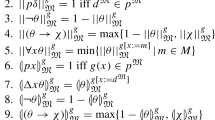Abstract
We consider the generalized equality sets which are of the form E G (a,g 1,g 2) = { w | g 1(w) = ag 2(w)}, determined by instances of the generalized Post Correspondence Problem, where the morphisms g 1 and g 2 are nonerasing and a is a letter. We are interested in the family consisting of the languages h(E G (J)), where h is a coding and J is a shifted equality set of the above form. We prove several closure properties for this family.
Access this chapter
Tax calculation will be finalised at checkout
Purchases are for personal use only
Preview
Unable to display preview. Download preview PDF.
Similar content being viewed by others
References
Ginsburg, S.: Algebraic and Automata-theoretic Properties of Formal Languages. North-Holland, Amsterdam (1975)
Halava, V., Harju, T., Hoogeboom, H.J., Latteux, M.: Valence Languages Generated by Generalized Equality Sets, Tech. Report 502, Turku Centre for Computer Science (August 2002) (submitted)
Harju, T., Karhumäki, J.: Morphisms. Handbook of Formal Languages. In: Rozenberg, G., Salomaa, A. (eds.), vol. 1, Springer, Heidelberg (1997)
Latteux, H., Leguy, J.: On the composition of morphisms and inverse morphisms. In: Díaz, J. (ed.) ICALP 1983. LNCS, vol. 154, pp. 420–432. Springer, Heidelberg (1983)
Latteux, H., Leguy, J.: On Usefulness of Bifaithful Rational cones. Math. Systems Theory 18, 19–32 (1985)
Păun, G.: A new generative device: valence grammars, Revue Roumaine de Math. Pures et Appliquées 6, 911–924 (1980)
Salomaa, A.: Formal Languages. Academic Press, New York (1973)
Author information
Authors and Affiliations
Editor information
Editors and Affiliations
Rights and permissions
Copyright information
© 2003 Springer-Verlag Berlin Heidelberg
About this paper
Cite this paper
Halava, V., Harju, T., Hoogeboom, H.J., Latteux, M. (2003). Languages Defined by Generalized Equality Sets. In: Lingas, A., Nilsson, B.J. (eds) Fundamentals of Computation Theory. FCT 2003. Lecture Notes in Computer Science, vol 2751. Springer, Berlin, Heidelberg. https://doi.org/10.1007/978-3-540-45077-1_33
Download citation
DOI: https://doi.org/10.1007/978-3-540-45077-1_33
Publisher Name: Springer, Berlin, Heidelberg
Print ISBN: 978-3-540-40543-6
Online ISBN: 978-3-540-45077-1
eBook Packages: Springer Book Archive




